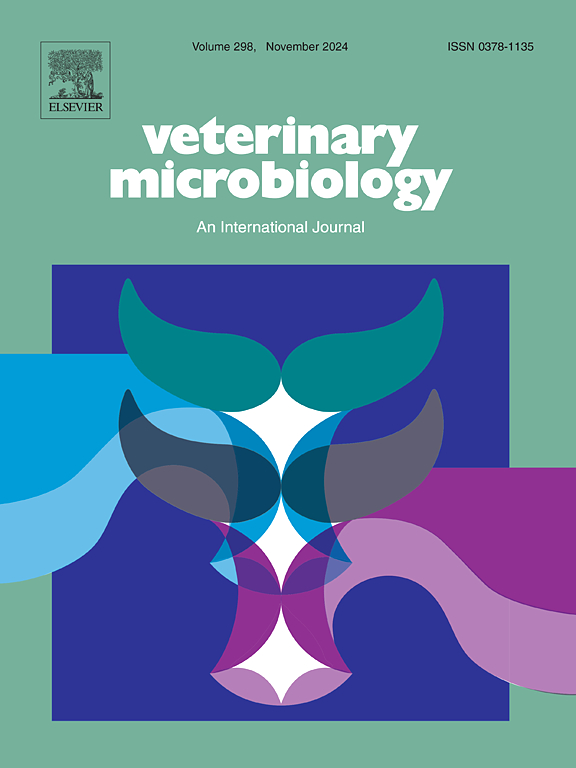The ITR regions play a significant role in modulating viral pathogenicity demonstrated by the reverse genetics system of a novel goose parvovirus
IF 2.7
2区 农林科学
Q3 MICROBIOLOGY
引用次数: 0
Abstract
Novel Goose Parvovirus (NGPV) a variant of goose parvovirus, induces typical short beak and dwarfism syndrome (SBDS) in Cherry Valley ducks. Clinically, SBDS is characterized by an atrophied and shortened beak, a protruding tongue, brittle and fracture-prone bones, and growth retardation. The Goose parvovirus genome harbors complex inverted repeat sequences (ITRs) at both ends of the genome. Currently, direct evidence elucidating the role of the ITR region in viral pathogenicity remains limited, hindering a comprehensive understanding of the pathogenic mechanism of goose parvovirus. In this study, we established a reverse genetics operating system for NGPV and successfully constructed and rescued two strains that differ exclusively in the ITR region at either genome terminus via transfection into duck embryos. Comparative pathogenicity analyses revealed distinct virulence profiles between the two rescued strains. This reverse genetic manipulation system provides an operational platform for studying goose parvovirus in the molecular biology, vaccine development, diagnosis, function of structural domains, and disease pathogenesis.
一种新型鹅细小病毒的反向遗传系统证明,ITR区域在调节病毒致病性中起重要作用。
新型鹅细小病毒(NGPV)是鹅细小病毒的一种变异,可引起樱桃谷鸭典型的短喙和侏儒综合征(SBDS)。临床表现为喙部萎缩缩短,舌部突出,骨骼易碎易骨折,生长迟缓。鹅细小病毒基因组在基因组的两端含有复杂的反向重复序列(ITRs)。目前,阐明ITR区在病毒致病性中的作用的直接证据仍然有限,阻碍了对鹅细小病毒致病机制的全面认识。在本研究中,我们建立了NGPV的反向遗传操作系统,并通过转染鸭胚胎成功构建和拯救了两个基因组两端ITR区完全不同的菌株。比较致病性分析揭示了两个获救菌株之间不同的毒力谱。该反向遗传操作系统为鹅细小病毒在分子生物学、疫苗研制、诊断、结构域功能和疾病发病机制等方面的研究提供了操作平台。
本文章由计算机程序翻译,如有差异,请以英文原文为准。
求助全文
约1分钟内获得全文
求助全文
来源期刊

Veterinary microbiology
农林科学-兽医学
CiteScore
5.90
自引率
6.10%
发文量
221
审稿时长
52 days
期刊介绍:
Veterinary Microbiology is concerned with microbial (bacterial, fungal, viral) diseases of domesticated vertebrate animals (livestock, companion animals, fur-bearing animals, game, poultry, fish) that supply food, other useful products or companionship. In addition, Microbial diseases of wild animals living in captivity, or as members of the feral fauna will also be considered if the infections are of interest because of their interrelation with humans (zoonoses) and/or domestic animals. Studies of antimicrobial resistance are also included, provided that the results represent a substantial advance in knowledge. Authors are strongly encouraged to read - prior to submission - the Editorials (''Scope or cope'' and ''Scope or cope II'') published previously in the journal. The Editors reserve the right to suggest submission to another journal for those papers which they feel would be more appropriate for consideration by that journal.
Original research papers of high quality and novelty on aspects of control, host response, molecular biology, pathogenesis, prevention, and treatment of microbial diseases of animals are published. Papers dealing primarily with immunology, epidemiology, molecular biology and antiviral or microbial agents will only be considered if they demonstrate a clear impact on a disease. Papers focusing solely on diagnostic techniques (such as another PCR protocol or ELISA) will not be published - focus should be on a microorganism and not on a particular technique. Papers only reporting microbial sequences, transcriptomics data, or proteomics data will not be considered unless the results represent a substantial advance in knowledge.
Drug trial papers will be considered if they have general application or significance. Papers on the identification of microorganisms will also be considered, but detailed taxonomic studies do not fall within the scope of the journal. Case reports will not be published, unless they have general application or contain novel aspects. Papers of geographically limited interest, which repeat what had been established elsewhere will not be considered. The readership of the journal is global.
 求助内容:
求助内容: 应助结果提醒方式:
应助结果提醒方式:


